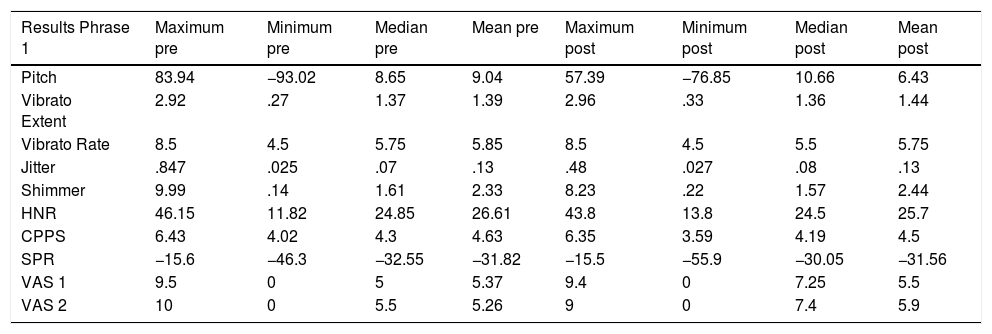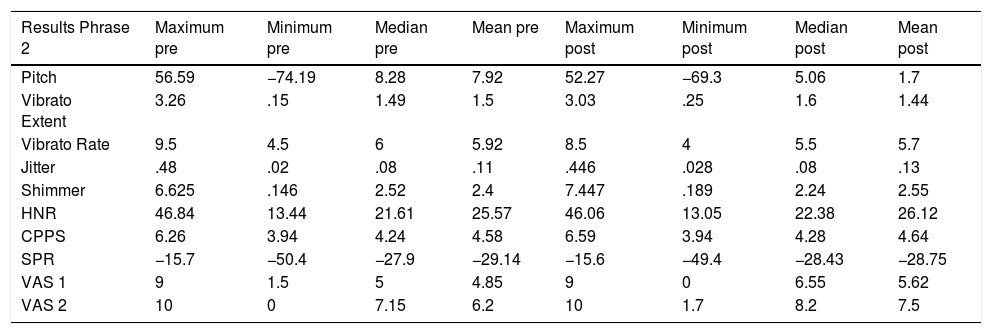Opera singing voice uses different technical tools for artistic purposes. We want to define if the quality of the sung sound is affected by an aware work on the musical accompaniment and the text. We analyse the acoustic signal and the subjective perception. The pitch studied in the soprano voice is A4 (880 Hz) with the vowel /a/. We have chosen a tone and a vowel that can be generated by different strategies in terms of phonoresonance adjustments.
Materials and methodsWe have carried out a prospective study with 20 sopranos, without voice pathology, who have sung a phrase from the aria Deh, vieni non tarda and another from the aria Dove sono i bei momenti from the opera Le nozze di Figaro, by W.A. Mozart. First, each phrase sung spontaneously was recorded and then a second time, after a proposed work on the content of the text and musical aspects of the accompaniment such as: rhythm, harmony, texture and direction of the phrase. The participants prolonged the emission of the A4 for more than three seconds, maintaining the context of the sentence. The acoustic signal has been analysed using the PRAAT programme and a VAS (Visual Analogue Scale) questionnaire has been used to collect subjective perceptions.
ResultsThe mean age was 36 ± 11 years (range between 20 and 58) and the mean number of years singing was 17 ± 12 years (range between 3 and 35). No statistically significant differences were found, although an improvement in the VAS was seen in the second sentence after the intervention.
ConclusionsThe acoustic analysis parameters are stable, and the VAS tends to improve when an awareness of the text and the instrumental accompaniment is carried out.
la voz cantada en canto de ópera utiliza diferentes mecanismos técnicos con finalidad artística. Queremos determinar si la calidad del sonido cantado se ve afectada por un trabajo consciente sobre el acompañamiento musical y el texto. Analizamos la señal acústica y la percepción subjetiva. La altura de tono estudiada en voz de soprano es el La4 (880 Hz) sobre la vocal /a/. Hemos elegido un tono y una vocal que pueden generarse mediante diferentes estrategias en cuanto a los ajustes fonorresonanciales.
Materiales y métodoshemos realizado un estudio prospectivo con 20 sopranos, libres de patología, que han cantado una frase del aria “Deh, vieni non tardar” y otra del aria “Dove sono i bei momenti” de la ópera Le nozze di Figaro, compuesta por W. A. Mozart. En primer lugar, se grabó cada frase cantada de modo espontáneo y una segunda vez, tras un trabajo propuesto sobre el contenido del texto y aspectos musicales del acompañamiento como son: ritmo, armonía, textura y dirección de la frase. Las participantes prolongaron la emisión del La4 algo más de 3 segundos manteniendo el contexto de la frase. La señal acústica ha sido analizada mediante el programa PRAAT y se ha utilizado un cuestionario EVA (Escala Visual Analógica) para recoger las percepciones subjetivas.
ResultadosLa media de edad fue de 36 años ± 11 años (rango entre 20 y 58), la media de años cantando fue de 17 ±12 años (rango entre 3 y 35). No se han encontrado diferencias estadísticamente significativas, aunque sí se aprecia una mejoría de la EVA en la segunda frase tras la intervención.
ConclusionesLos parámetros de análisis acústico son estables y la EVA tiende a mejorar cuando se realiza un trabajo de toma de conciencia del texto y el acompañamiento instrumental.











